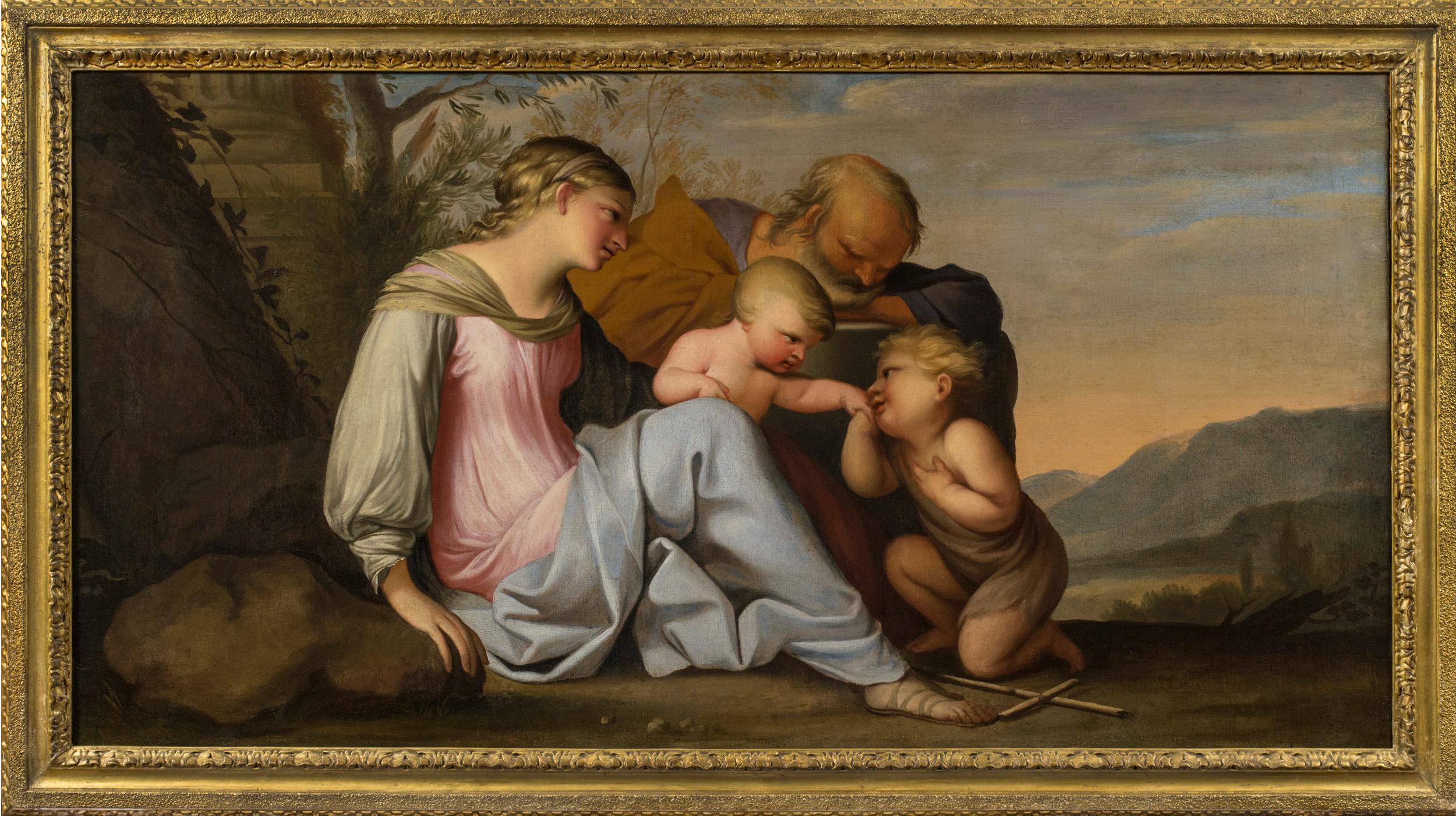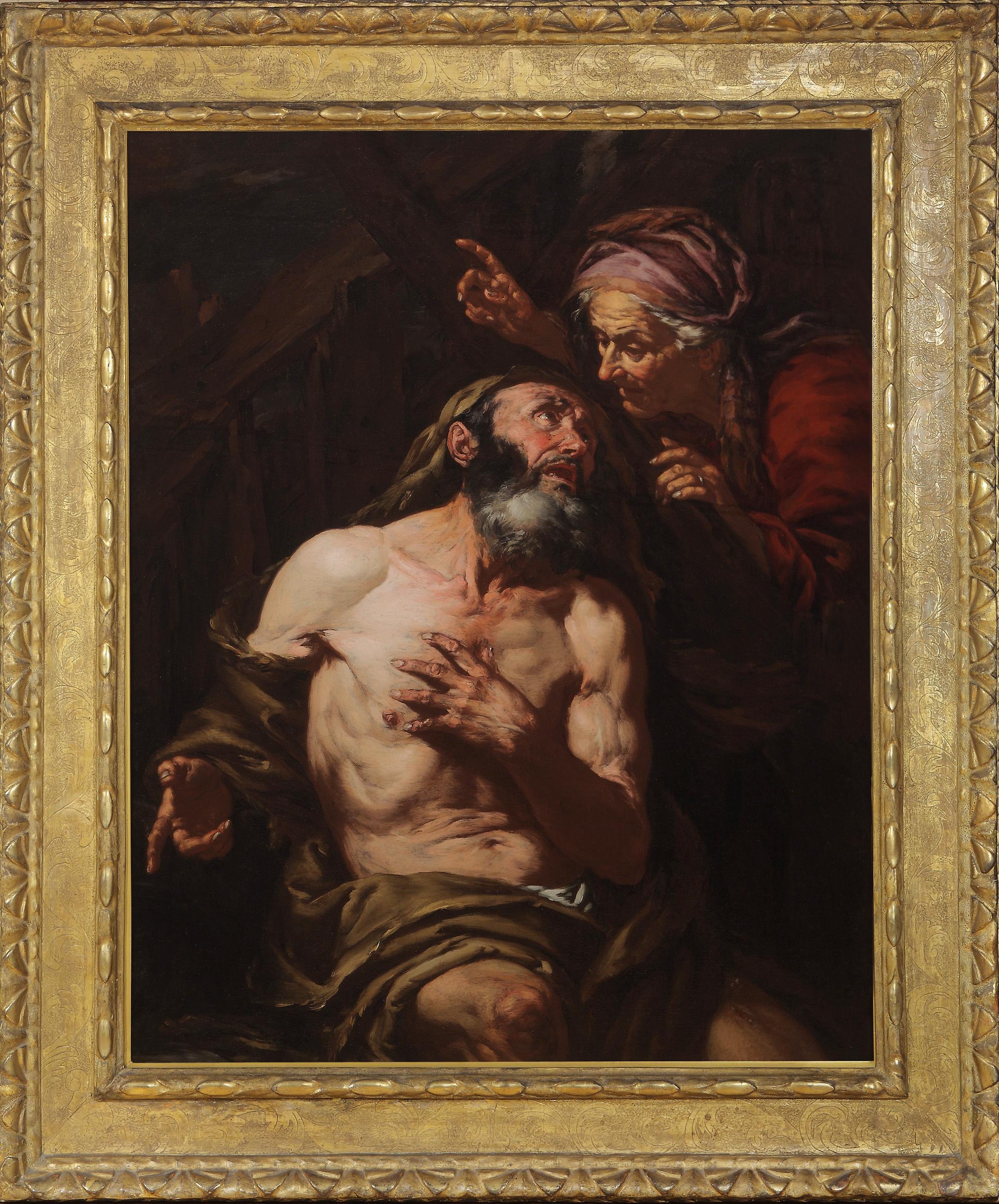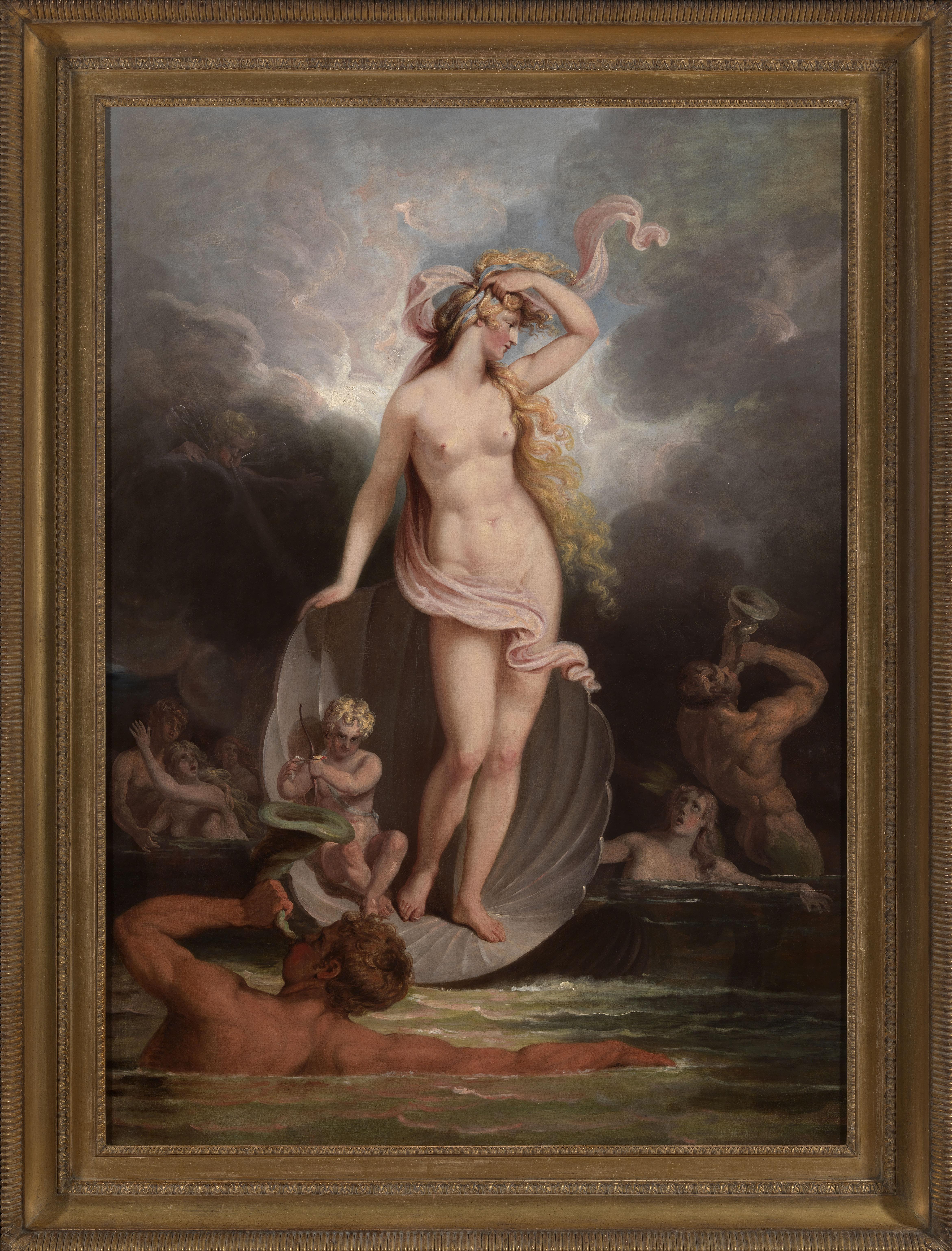Items Similar to Saint Francis of Assisi comforted by an angel
Want more images or videos?
Request additional images or videos from the seller
1 of 11
Guglielmo Caccia said the Moncalvo (Montabone, 1568 - Moncalvo, 1625)Saint Francis of Assisi comforted by an angel1615-1625
1615-1625
About the Item
Guglielmo Caccia said the Moncalvo
(Montabone, 1568 - Moncalvo, 1625)
Saint Francis of Assisi comforted by an angel
Oil on canvas, cm 96 x 73 - (with frame 106 x 83 cm)
With an intense gaze, from which a severe spiritual travail shines, Saint Francis welcomes the apparition of the musician angel who has come to comfort his solitary meditation. Nothing distracts attention from the silent conversation between the celestial figure and the saint of Assisi, except the humble crock bowl that can be seen on the table that acts as a support to the left hand of the saint.
The expressive concentration that pervades the representation correspond to a very reduced color gamut and an essential pictorial conduction, built with a diaphanous material, almost transparent, which lets emerge from the bottom traces of the basic design and warm tones of the preparation, as if to dematerialize the image.
Taking into account these executive characters and the typologies of the two protagonists of our painting, it appears immediately to be traced back to the production of Guglielmo Caccia known as Moncalvo (1568-1625)in which it is given to find numerous points of comparison with Saint Francis here under examination. The figure of the saint of Assisi recurs frequently in the work of the Piedmontese painter already starting from the Madonna and Child and Saints of Cioccaro di Penango (Asti) of 1602, an altarpiece of the first maturity of the artist in which we find a Saint Francis profile very close to that observable in our canvas (cf. Guglielmo Caccia known as il Moncalvo. Paintings and drawings, catalogue of the exhibition curated by G. Romano, C. E. Spantigati, Turin, 1997, pp. 50-51, n. 2). The expressive accentuation and the chromatic rarefaction that characterize our Saint Francis lead however to place it in the last stretch of the artist’s career, that is after his important stay in Lombardy, where it is long attested during the second decade of the seventeenth century.
The path of Moncalvo, after a first period of activity in the native Monferrato and in the neighboring areas sees the painter summoned to the court of Savoy in Turin, where between 1605 and 1608 he is called to work alongside Federico Zuccari in the fresco decoration of the Great Gallery commissioned by Duke Carlo Emanuele I as a spectacular link between the ancient castle (now Palazzo Madama) and the new ducal palace. The participation in this great enterprise - unfortunately lost - guarantees Moncalvo a leading position in the pictorial panorama not only of Piedmont but also of Lombardy, where Moncalvo receives numerous prestigious commissions, like those in the Milanese churches of Sant'Alessandro, Sant'Antonio Abate, Sant'Angelo and San Vittore, in the Duomo of Monza, in Como (altarpiece of the high altar of Sant'Orsola: cfr. Pittura a Como e nel Canton Ticino dal Mille al Settecento, edited by M. Gregori, Milano, 1994, p. 174, n. 94) and in several churches in Pavia (for a profile of the painter: G. Romano, Caccia Gugliemo detto il Moncalvo, in Dizionario Biografico degli Italiani, Roma, vol. 15, 1972, pp. 758-762; Guglielmo Caccia detto il Moncalvo. Paintings and drawings, exhibition catalogue curated by G. Romano, C. E. Spantigati, Torino, 1997). The contact with the Lombard figurative climate, dominated by the pathetic face of the artists dear to Giovanni Testori - Cerano, Morazzone and Giulio Cesare Procaccini - determines a certain expressive intensification of the style of Moncalvo, as the San Francesco presented here clearly states, to be read keeping in mind the dramatic depictions produced by the protagonists of the Milanese painting of the early seventeenth century.
Among the late works of Moncalvo a timely comparison for the figure of San Francesco comforted by the angel can be found in the altarpiece of 1623 depicting the Madonna and Child with Saints in the church of San Siro in Lugano-Carabbia (cf. Pittura a Como e nel Canton Ticino dal Mille al Settecento, curated by M. Gregori, Milano, 1994, p. 201, n. 121), in which appears a Saint Francis entirely similar to the one presented here.
All works sold by us are accompanied by a certificate of authenticity and analytical study of the work.
We ship the painting in a solid wooden case made to measure
We remain at your disposal for any further information.
- Creator:Guglielmo Caccia said the Moncalvo (Montabone, 1568 - Moncalvo, 1625) (1568 - 1625, Italian)
- Creation Year:1615-1625
- Dimensions:Height: 41.74 in (106 cm)Width: 32.68 in (83 cm)
- Medium:
- Movement & Style:
- Period:Early 17th Century
- Condition:As seen in the photographs, the painting has been restored and, in the past, has been relined.
- Gallery Location:Como, IT
- Reference Number:1stDibs: LU2536212330232
About the Seller
5.0
Vetted Seller
These experienced sellers undergo a comprehensive evaluation by our team of in-house experts.
Established in 1993
1stDibs seller since 2023
- ShippingRetrieving quote...Ships From: Como, Italy
- Return PolicyA return for this item may be initiated within 14 days of delivery.
More From This SellerView All
- Portrait of a MusketeerLocated in Como, ITTITO CONTI (Florence 1842 - 1924) Portrait of a Musketeer Oil on canvas in gilded frame Signed in the upper right Canvas measures 40x30 cm (51x43 cm includ...Category
19th Century Figurative Paintings
MaterialsCanvas, Oil
- The Holy Family with Saint John the BaptistLocated in Como, ITCircle of Bernardo Castello (1557-1629) The Holy Family with Saint John the Baptist 1600-1615 circa Oil on canvas in gilded frame Measures in cm: 84 x 63 cm (104 x 84 cm including frame) Measures in inch: 33.07 x 24.80 in (40,95 x 33,08 in including the frame) One of the most widespread iconographies in Italian painting from the Renaissance onwards, that of the Holy Family, is set in a sober and at the same time elegant interior, as the presence of the gold-edged green curtain that closes the space like a backdrop states. Whether it takes place in the intimacy of the house in Nazareth, as in the painting presented here, or it is placed outdoors, the scene includes the presence in the role of protagonists of the Madonna and Child Jesus, flanked by the protective figure of Joseph, always held a slightly aloof. In some cases, including ours, the Child is in dialogue with the little John the Baptist, thus alluding to the role played by the latter in the history of salvation, as the gesture of Jesus explicitly indicates in our canvas, who blesses the one who will be destined to baptize him in the waters of the Jordan. The 'room' dimensions, the calm religious intonation that pervades the representation, underlined by the very evident presence of the haloes, attest that the painting was conceived for the private devotion of its client and probably intended for a bedroom or for the walls of a small home chapel. The cleaning carried out in recent times allows you to appreciate the bright and lively chromatic range, orchestrated on the refined harmony between the shades of the Virgin's robes - blue and carmine red - and the bright green of the curtain that forms the backdrop to the scene. A particularly delicate pictorial drafting, well appreciated in the soft rendering of the faces and limbs of the two children - observe, for example, the suffused chiaroscuro transitions of the face of Jesus - is combined with a sensitive and tender description of the 'affects', allowing us to place this painting in the context of the painting of the Catholic Counter-Reformation and of the principles of verisimilitude and naturalness advocated by it in reaction to the expressive licenses and formal abstractions of the Mannerist figurative culture derived from Michelangelo's lesson. The return to a sober and juxtaposed pictorial language and simplified compositional schemes, often inspired by the early sixteenth century examples of Raphael and Andrea del Sarto, which we also recognize in our Holy Family, characterizes the work of numerous artists scattered throughout the various centers of the Peninsula , from the Bologna of the Carracci, to the Tuscany of Santi di Tito, to the Marche of Federico Barocci, up to Rome, Naples and Milan, where Camillo Procaccini and Guglielmo Caccia...Category
Early 17th Century Figurative Paintings
MaterialsCanvas, Oil
- Portrait of a ButteroLocated in Como, ITTITO CONTI (Florence 1842 - 1924) Portrait of a Buttero Oil on canvas in gilded frame Signed in the upper right Canvas measures 40x30 cm (51x43 cm includin...Category
19th Century Figurative Paintings
MaterialsCanvas, Oil
- Ear Market - Chioggia 1936Located in Como, ITLeonardo Bazzaro (Milan, 1853 - 1937) Ear Market • Chioggia 1936 Signed lower right Oil on panel in gilt frame Size: 60 x 90 cm (82 x 112 cm including frame) The son of a cloth ...Category
20th Century Figurative Paintings
MaterialsCanvas, Oil
- Grazing HorseLocated in Como, ITRuggero Panerai (Firenze 1862-1923) Grazing horse Oil on canvas in gilded frame Canvas size 100x70 cm (116x86 cm with frame) Signed at the bottom left Last quarter 19th century Ruggero Panerai was born in Florence on 13 March 1862. He was employed as a carpenter until the age of fifteen and then studied at the Academy of Fine Arts in Florence, which he attended from 1877 to 1881. His teacher was Giovanni Fattori, who introduced him to the naturalistic painting of landscapes of the Tuscan Maremma and considered him among his most deserving students. Factors' teachings were decisive in orienting the young artist, who adopted the themes and the pictorial technique, updating them with the naturalism flowered in Tuscany through the example of Luigi and Francesco Gioli, Tommasi and Egisto Ferroni. In 1883 he exhibited at the Promotrice in Florence, his impressionism was inspired by the works of Guido Carocci. His painting is also affected by the bourgeois and worldly look of Giuseppe De Nittis and the manner of Vittorio Matteo Corcos who for some years lived in Paris but who returned to Livorno from time to time. Useful for a contact with the Parisian culture could also have been, for Panerai, the proximity with Francesco and Luigi Gioli, who in 1878 went to the French capital, where they had frequented Federico Zandomeneghi. Panerai was also attracted by the military theme. Military subjects are in fact among the most practiced and loved by the artist, who declines them in numerous variations, mostly devoid of pathos, but adhering to a quiet image. In 1887 his painting "Il Guado", presented in Venice, was chosen for the National Gallery of Modern and Contemporary Art in Rome, but instead entered the "Pisani" Gallery. In the same year he exhibited in Genoa, Florence and Milan, where he won the Fumagalli Prize with "Il cavallo malato" (Florence, Galleria d'arte moderna of Palazzo Pitti), a painting in which his qualities as a sensitive animalist painter stand...Category
19th Century Animal Paintings
MaterialsCanvas, Oil
- Ettore Cosomati (1871-1960) Still life of Marigolds with lemons and pipeLocated in Como, ITEttore Cosomati (Naples 1871 - Milan 1960) Still life of Marigolds with lemons and pipe Oil on canvas in gilded frame Size: 53 x 45 cm (73 x 64 cm including frame) Epoch: the paint...Category
Early 20th Century Still-life Paintings
MaterialsCanvas, Oil
You May Also Like
- Italian 18th Century Oval Religious Oil on Canvas Painting with Saint DominicBy Francesco de MuraLocated in Firenze, ITThis beautiful Italian 18th Century old masters oil painting on oval canvas with giltwood frame is attributed to Solimena and features a religious scene. In this splendid oval-shaped painting are depicted Saint Dominic...Category
18th Century Old Masters Figurative Paintings
MaterialsOil, Canvas
- Head of an AngelLocated in New York, NYProcaccini was born in Bologna, but his family moved to Milan when the artist was eleven years old. His artistic education was evidently familial— from his father Ercole and his elder brothers Camillo and Carlo Antonio, all painters—but his career began as a sculptor, and at an early age: his first known commission, a sculpted saint for the Duomo of Milan, came when he was only seventeen years old. Procaccini’s earliest documented painting, the Pietà for the Church of Santa Maria presso San Celso in Milan, was completed by 1604. By this time the artist had made the trip to Parma recorded by his biographers, where he studied Correggio, Mazzola Bedoli, and especially Parmigianino; reflections of their work are apparent throughout Procaccini's career. As Dr. Hugh Brigstocke has recently indicated, the present oil sketch is preparatory for the figure of the angel seen between the heads of the Virgin and St. Charles Borrommeo in Procaccini's altarpiece in the Church of Santa Afra in Brescia (ill. in Il Seicento Lombardo; Catalogo dei dipinti e delle sculture, exh. cat. Milan 1973, no. 98, pl. 113). As such it is the only known oil sketch of Procaccini's that can be directly connected with an extant altarpiece. The finished canvas, The Virgin and Child with Saints Charles Borrommeo and Latino with Angels, remains in the church for which it was painted; it is one of the most significant works of Procaccini's maturity and is generally dated after the artist's trip to Genoa in 1618. The Head of an Angel is an immediate study, no doubt taken from life, but one stylistically suffused with strong echoes of Correggio and Leonardo. Luigi Lanzi, writing of the completed altarpiece in 1796, specifically commented on Procaccini's indebtedness to Correggio (as well as the expressions of the angels) here: “Di Giulio Cesare...Category
17th Century Old Masters Figurative Paintings
MaterialsCanvas, Paper, Oil
- An Architectural Capriccio with the Preaching of an ApostleBy Giovanni Paolo PaniniLocated in New York, NYProvenance: Santambrogio Antichità, Milan; sold, 2007 to: Filippo Pernisa, Milan; by whom sold, 2010, to: Private Collection, Melide, Switzerland De Primi Fine Art, Lugano, Switzerland; from whom acquired, 2011 by: Private Collection, Connecticut (2011-present) Literature: Ferdinando Arisi, “Ancora sui dipinti giovanili del Panini,” Strenna Piacentina (Piacenza, 2009): pp. 48, 57, 65, fig. 31, as by Panini Ferdinando Arisi, “Panini o Ghisolfi o Carlieri? A proposito dei dipinti giovanili,” Strenna Piacentina, (Piacenza, 2010), pp. 100, 105, 116, fig. 101, as an early work by Panini, a variant of Panini’s painting in the Museo Cristiano, Esztergom, Hungary. This architectural capriccio is one of the earliest paintings by Giovanni Paolo Panini, the preeminent painter of vedute and capricci in 18th-century Rome. The attribution to Panini has been endorsed by Ferdinando Arisi, and a recent cleaning of the painting revealed the artist’s signature in the lower right. Like many of his fellow painters working in Rome during his day, Panini was not a native of the Eternal City. He first trained as a painter and stage designer in his hometown of Piacenza and moved to Rome at the age of 20 in November 1711 to study figure painting. Panini joined the workshop of Benedetto Luti (1666-1724) and from 1712 was living on the Piazza Farnese. Panini, like many before and after him, was spellbound by Rome and its classical past. He remained in the city for the rest of his career, specializing in depicting Rome’s most important monuments, as well as creating picturesque scenes like this one that evoked the city’s ancient splendor. The 18th century art historian Lione Pascoli, who likely knew Panini personally, records in his 1730 biography of the artist that when Panini came to Rome, he was already “an excellent master and a distinguished painter of perspective, landscape, and architecture.” Panini’s earliest works from this period still show the evidence of his artistic formation in Piacenza, especially the influence of the view painter Giovanni Ghisolfi (1623-1683). However, they were also clearly shaped by his contact in Rome with the architectural capricci of Alberto Carlieri...Category
18th Century Old Masters Figurative Paintings
MaterialsCanvas, Oil
- Holy Family with the Infant St. John the BaptistLocated in New York, NYLubin Baugin (Pithiviers 1610 – 1663 Paris) Holy Family with the Infant Saint John the Baptist Oil on canvas 22 x 42 ¼ inches (55.9 x 107.3 cm) Provenance: Marcello and Carlo ...Category
17th Century Old Masters Figurative Paintings
MaterialsCanvas, Oil
- Job Cursed by His WifeBy Giovanni Battista LangettiLocated in New York, NYProvenance: Alfred (1883-1961) and Hermine Stiassni (1889-1962), Brno, Czech Republic, by 1925; thence London, 1938-1940; thence Los Angeles, 1940-1962; thence by descent to: Susanne Stiassni Martin and Leonard Martin, San Francisco, until 2005; thence by descent to: Private Collection, California Exhibited: Künstlerhaus, Brünn (Brno), 1925, as by Ribera. “Art of Collecting,” Flint Institute of Art, Flint, Michigan, 23 November 2018 – 6 January 2019. Literature: Alte Meister...Category
1670s Old Masters Paintings
MaterialsCanvas, Oil
- 18th century allegorical painting of The Triumph of BeautyLocated in London, GBExhibited: London, Royal Academy, 1800, no. 93 What was happening in British history painting in around 1800? In recent discussions of the emergence of a British School of history painting following the foundation of the Royal Academy in 1768, this is a question which is rarely posed and one which is not easily answered. Examination of surviving Royal Academy exhibition catalogues reveals a profusion of artists’ names and titles, few of which remain immediately recognizable, whilst endeavours to explain the impact of exhibition culture on painting - such as the 2001 Courtauld show Art on the Line - have tended to focus on the first and second generation of Royal Academician, rather than young or aspiring artists in the early nineteenth century. This makes the discovery and identification of the work under discussion of exceptional importance in making sense of currents in English painting around 1800. Executed by Edward Dayes...Category
18th Century Old Masters Figurative Paintings
MaterialsCanvas, Oil




